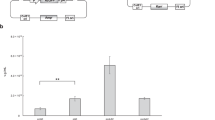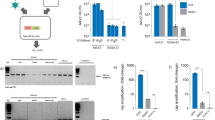Abstract
Adeno-associated virus (AAV) vectors are a practical choice for gene transfer, and demand for them is increasing. To cope with the necessity in the near future, we have developed a number of approaches to establish packaging cell lines for the production of AAV vectors. In our previous study, a highly regulated expression of large Rep proteins was obtained by using the Cre-loxP switching system. Therefore, in the present study, to regulate Cap expression as well, we developed an inducible expression system for both Rep and Cap proteins by using an additional set of mutant loxP sequences. The mutants possess two base alterations in the spacer region of loxP and recombine specifically with the same counterpart in the presence of Cre. By using two separate plasmids, one with mutant and the other with wild-type loxP sequences, the expression of two different proteins can be induced simultaneously by Cre recombinase. When the LacZencoding plasmid vector was used as a packaging model, a significant packaging titer of 2.1 × 1010 genome copies per 10-cm dish was obtained. These results indicate the importance of controlling Cap expression, in addition to Rep, to achieve an optimum production rate for AAV vectors.
Similar content being viewed by others
References
Kay, M. A., Manno, C. S., Ragni, M. V., et al. (2000) Evidence for gene transfer and expression of factor 1X in haemophilia B patients treated with an AAV vector. Nat Genet. 24, 257–261.
During, M. J., Kaplitt, M. G., Stern, M. B., and Eidelberg, D. (2001) Subthalamic GAD gene transfer in Parkinson disease patients who are candidates for deep brain stimulation. Hum. Gene Ther. 12, 1589–1591.
Muramatsu, S., Fujimoto, K., Ikeguchi, K., et al. (2002) Behavioral recovery in a primate model of Parkinson’s disease by triple transduction of striatal cells with adeno-associated viral vectors expressing dopamine-synthesizing enzymes. Hum. Gene Ther. 13, 345–354.
Ogasawara, Y., Mizukami, H., Urabe, M., et al. (1999) Highly regulated expression of adeno-associated virus large Rep proteins in stable 293 cell lines using the Cre/loxP switching system. J. Gen. Virol. 80, 2477–2480.
Okada, T., Mizukami, H., Urabe, M., et al. (2001) Development and characterization of an antisense-mediated prepackaging cell line for adeno-associated virus vector production. Biochem. Biophys. Res. Commun. 288, 62–68.
Holscher, C., Horer, M., Kleinschmidt, J. A., Zentgraf, H., Burkle, A., and Heilbronn, R. (1994) Cell lines inducibly expressing the adeno-associated virus (AAV) rep gene: requirements for productive replication of rep-negative AAV mutants. J. Virol. 68, 7169–7177.
Yang, Q., Chen, F., and Trempe, J. P. (1994) Characterization of cell lines that inducibly express the adenoassociated virus Rep proteins. J. Virol. 68, 4847–4856.
Lee, G. and Saito, I. (1998) Role of nucleotide sequences of loxP spacer region in Cre-mediated recombination. Gene 216, 55–65.
Graham, F. L., Smiley, J., Russell, W. C., and Nairn, R. (1977) Characteristics of a human cell line transformed by DNA from human adenovirus type 5. J. Gen. Virol. 36, 59–74.
Orban, P. C., Chui, D., and Marth, J. D. (1992) Tissueand site-specific DNA recombination of transgenic mice. Proc. Natl. Acad. Sci. USA 89, 6861–6865.
Niwa, H., Yamamura, K., and Miyazaki, J. (1991) Efficient selection for high-expression transfectants with a novel eukaryotic vector. Gene 108, 193–199.
Wigler, M., Pellicer, A., Silverstein, S., and Axel, R. (1978) Biochemical transfer of single-copy eukaryotic genes using total cellular DNA as a donor. Cell 14, 725–731.
Kanegae, Y., Lee, G., Sato, Y., et al. (1995) Efficient gene activation in mammalian cells by using recombinant adenovirus expressing site-specific Cre recombinase. Nucleic Acids Res. 23, 6816–3821.
Gao, G. P., Qu, G., Faust, L. Z., et al. (1998) High-titer adeno-associated viral vectors from a Rep/Cap cell line and hybrid shuttle virus. Hum. Gene Ther. 9, 2353–2362.
Inoue, N. and Russell, D. W. (1998) Packaging cells based on inducible gene amplification for the production of adeno-associated virus vectors. J. Virol. 72, 7024–7031.
Ogasawara, Y., Urabe, M., Kogure, K., et al. (1999) Efficient production of adeno-associated virus vectors using split-type helper plasmids. Jpn. J. Cancer Res. 90, 476–483.
Kiwaki, K., Kanegae, Y., Saito, I., et al. (1996) Correction of ornithine transcarbamylase deficiency in adult spf(ash) mice and in OTC-deficient human hepatocytes with recombinant adenoviruses bearing the CAG promoter. Hum. Gene Ther. 7, 821–830.
Author information
Authors and Affiliations
Corresponding author
Rights and permissions
About this article
Cite this article
Mizukami, H., Okada, T., Ogasawara, Y. et al. Separate control of rep and cap expression using mutant and wild-type LoxP sequences and improved packaging system for adeno-associated virus vector production. Mol Biotechnol 27, 7–14 (2004). https://doi.org/10.1385/MB:27:1:07
Issue Date:
DOI: https://doi.org/10.1385/MB:27:1:07




